Engineering Behavior and Characteristics of Wood Ash and Sugarcane Bagasse Ash
Abstract
:1. Introduction
2. Literature Review
2.1. Biomass Classification
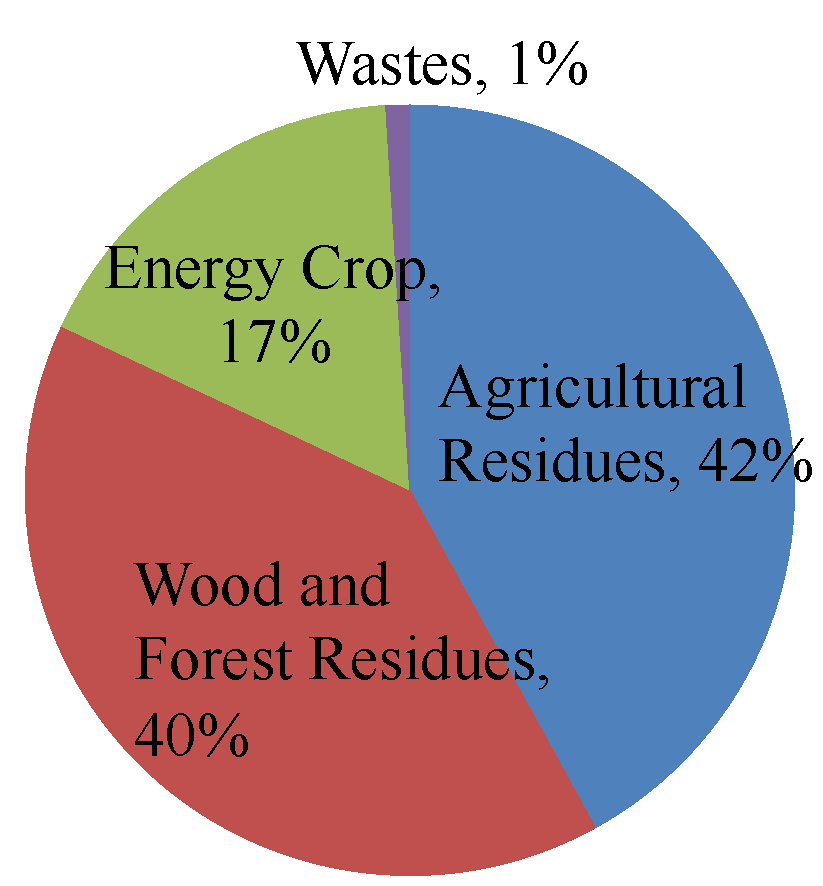
2.2. Physical and Chemical Properties of Biomass
| Materials | Average Particle Diameter (d50) (mm) | Bulk Density (kg/m³) | Specific Surface Area (m²/kg) |
|---|---|---|---|
| Wood ash | 0.230 | 663—977 | 4200—100,600 |
| Sugarcane bagasse ash | 0.023 | 410—590 | 900—943 |
| Coal fly ash Class C | 0.208 | 750—800 | 392—471 |
3. Experimental Section
3.1. Materials
3.2. Sample Preparation
3.3. Experimental Methods

4. Experimental Results
4.1. Basic Properties of Biomass Ashes
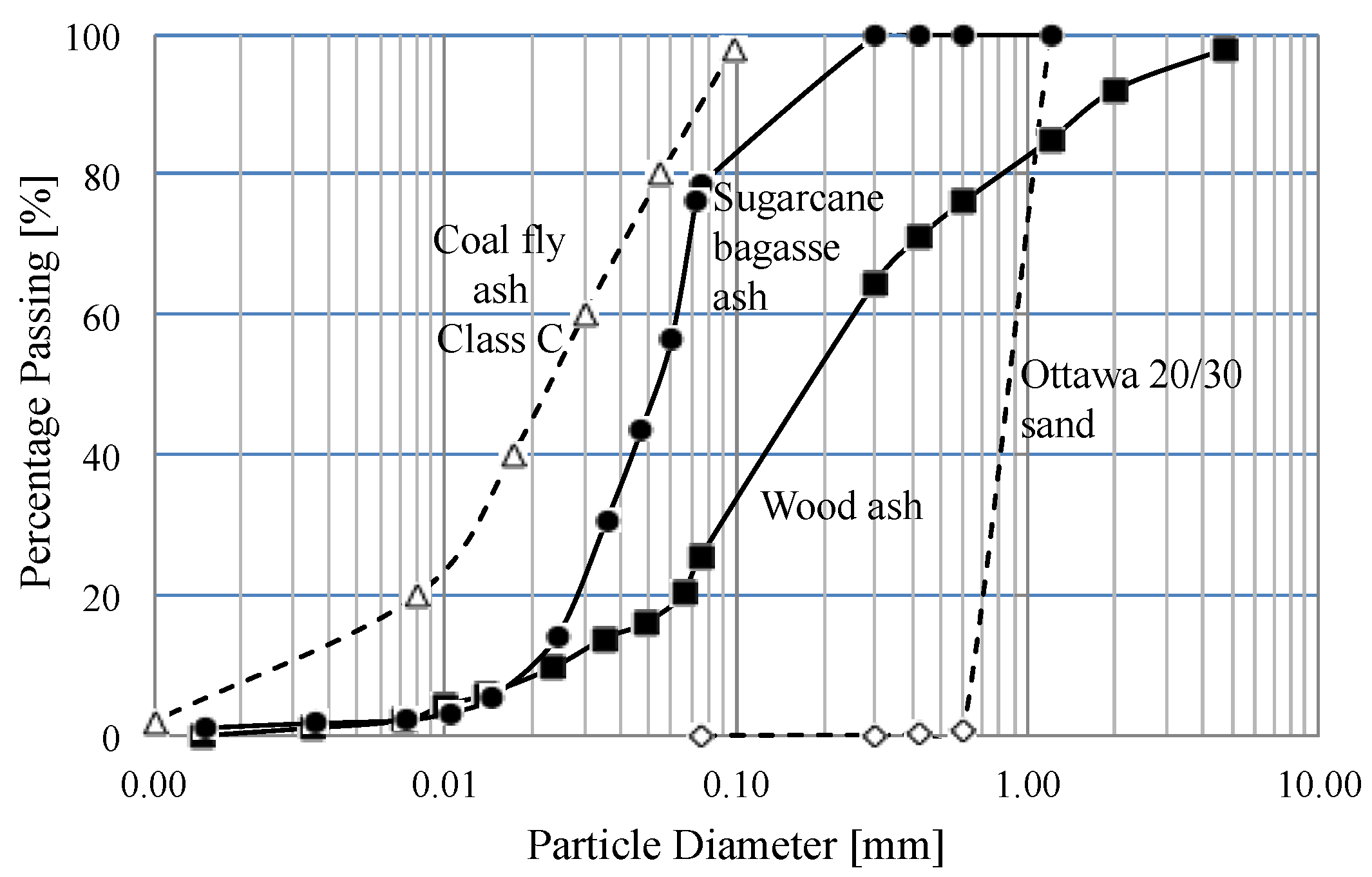
| Test | Ottawa 20/30 Sand | Coal Fly Ash Class C | Wood Ash | Sugarcane Bagasse Ash |
|---|---|---|---|---|
| d10 (mm) | 0.650 | 0.003 | 0.025 | 0.020 |
| d30 (mm) | 0.750 | 0.013 | 0.090 | 0.046 |
| d50 (mm) | 0.870 | 0.022 | 0.180 | 0.055 |
| d60 (mm) | 0.900 | 0.030 | 0.260 | 0.063 |
| Cu | 1.38 | 10.00 | 10.40 | 3.15 |
| Cc | 0.96 | 1.88 | 1.25 | 1.68 |
| Specific surface area (m2/kg) | 411~423 | 12,025~14,025 | 922~932 | |
| Gs | 2.65 | 2.58 | 2.41 | 2.34 |
| pH | 4.01 | - | 12.57 | 8.65 |

| Constituents | Coal Fly Ash Class C | Wood Ash | Sugarcane Bagasse Ash |
|---|---|---|---|
| SiO2 | 52.4 | 32.8 | 84.2 |
| Al2O3 | 26.5 | 27.0 | 5.3 |
| Fe2O3 | 7.5 | 2.2 | 2.9 |
| CaO | 8.7 | 11.7 | 2.0 |
| MgO | 3.0 | 9.1 | 1.0 |
| SO3 | 1.9 | - | - |
| Na2O | - | 6.7 | - |
| K2O | - | 10.5 | 4.6 |
| Heavy Metal | EPA | Sugarcane Bagasse Ash | Wood Ash | Fly ash Class C Type |
|---|---|---|---|---|
| Barium (Ba) | 100 | 0.148 | 0.4608 | 1.72476 |
| Arsenic (As) | 5 | 0.00445 | bdl | 0.003935 |
| Cadmium (Cd) | 1 | 0.00185 | nd | 0.000845 |
| Chromium (Cr) | 5 | 0.0326 | 0.0328 | 0.036285 |
| Lead (Pb) | 5 | nd | 0.0116 | 0.010215 |
| Mercury (Hg) | 0.2 | nd | nd | nd |
| Selenium (Se) | 1 | nd | nd | nd |
4.2. Hydraulic Conductivity
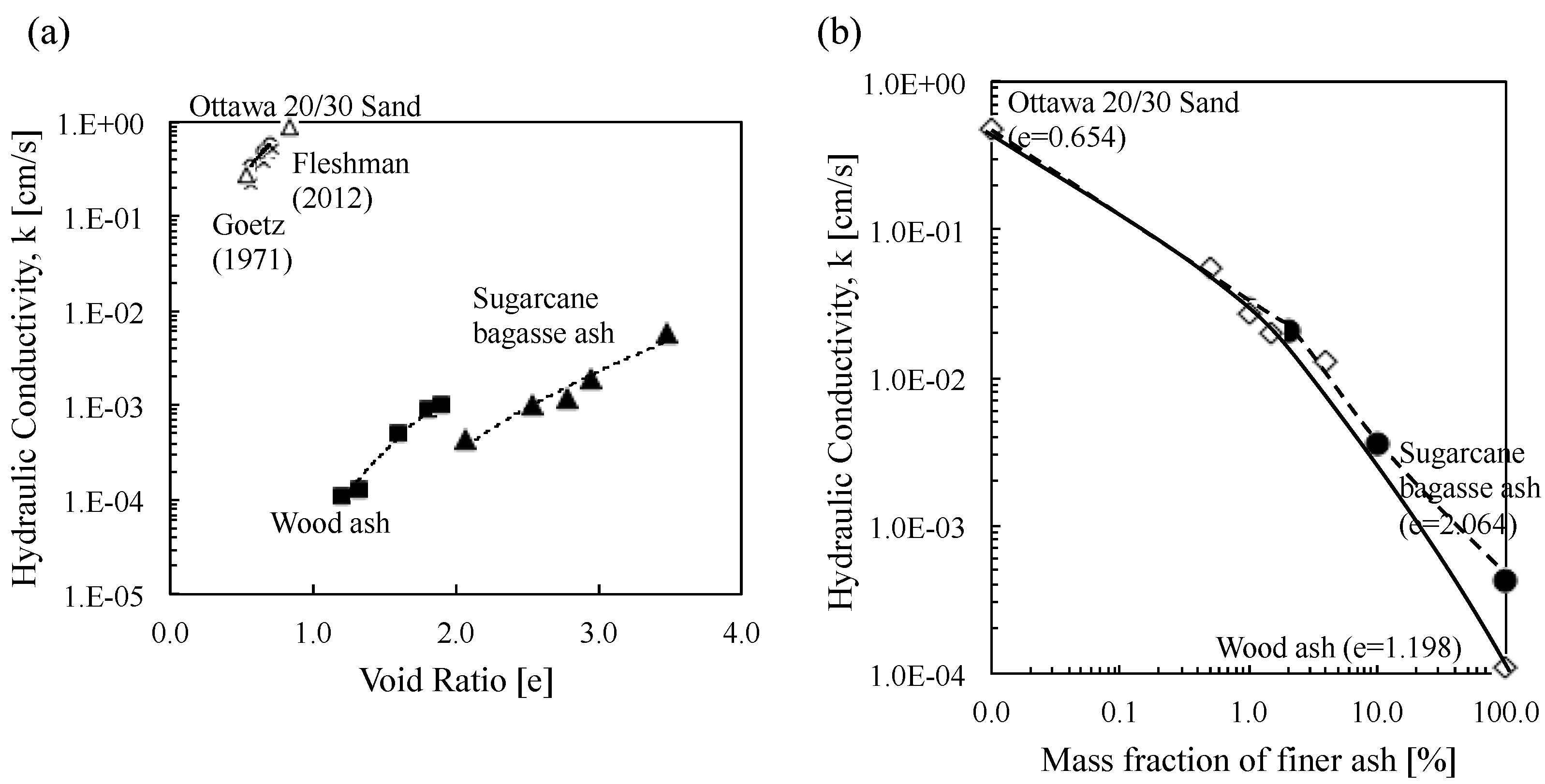
4.3. Consolidation
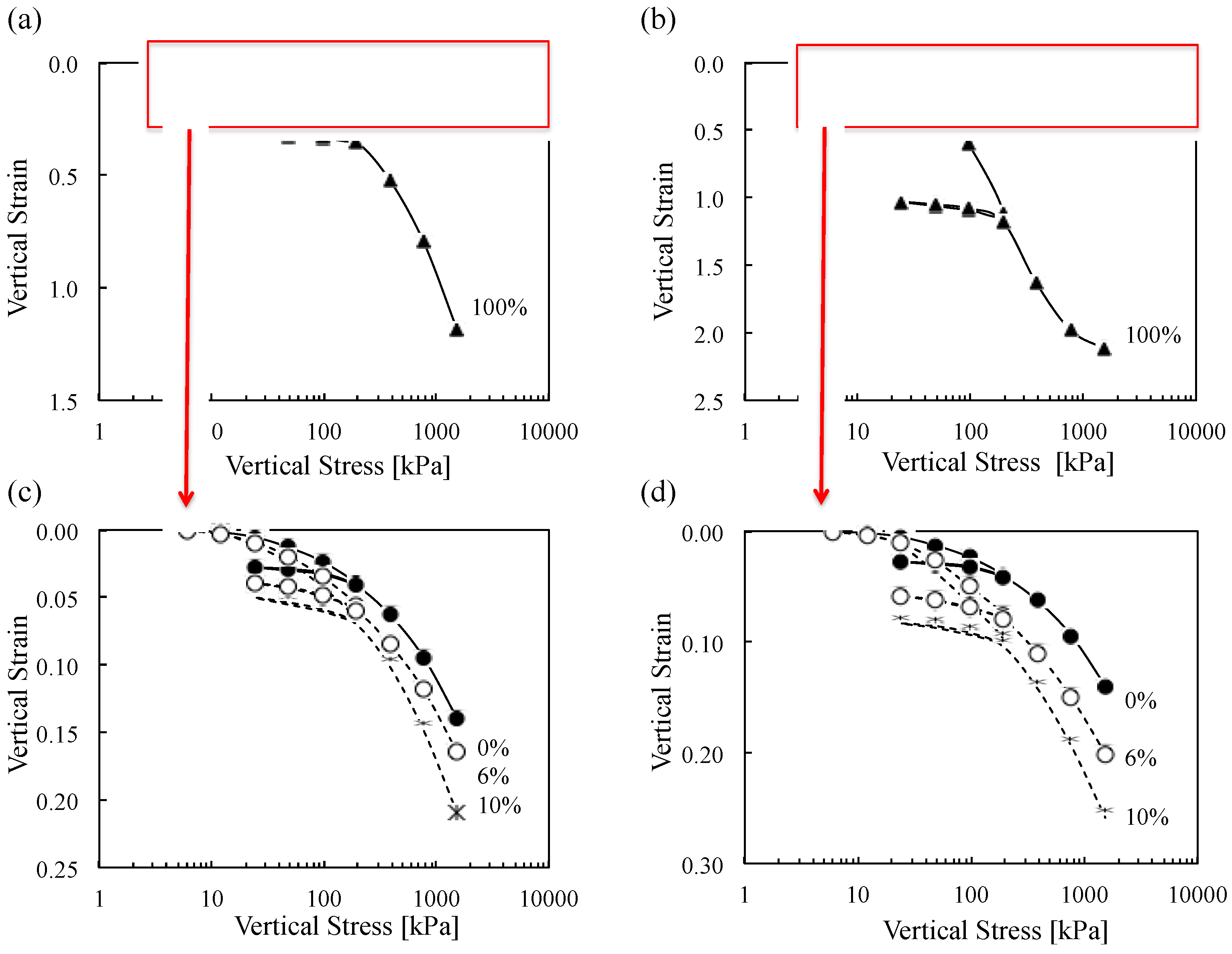

4.4. Shear Wave Velocity

5. Analysis and Discussion
5.1. Hydraulic Conductivity
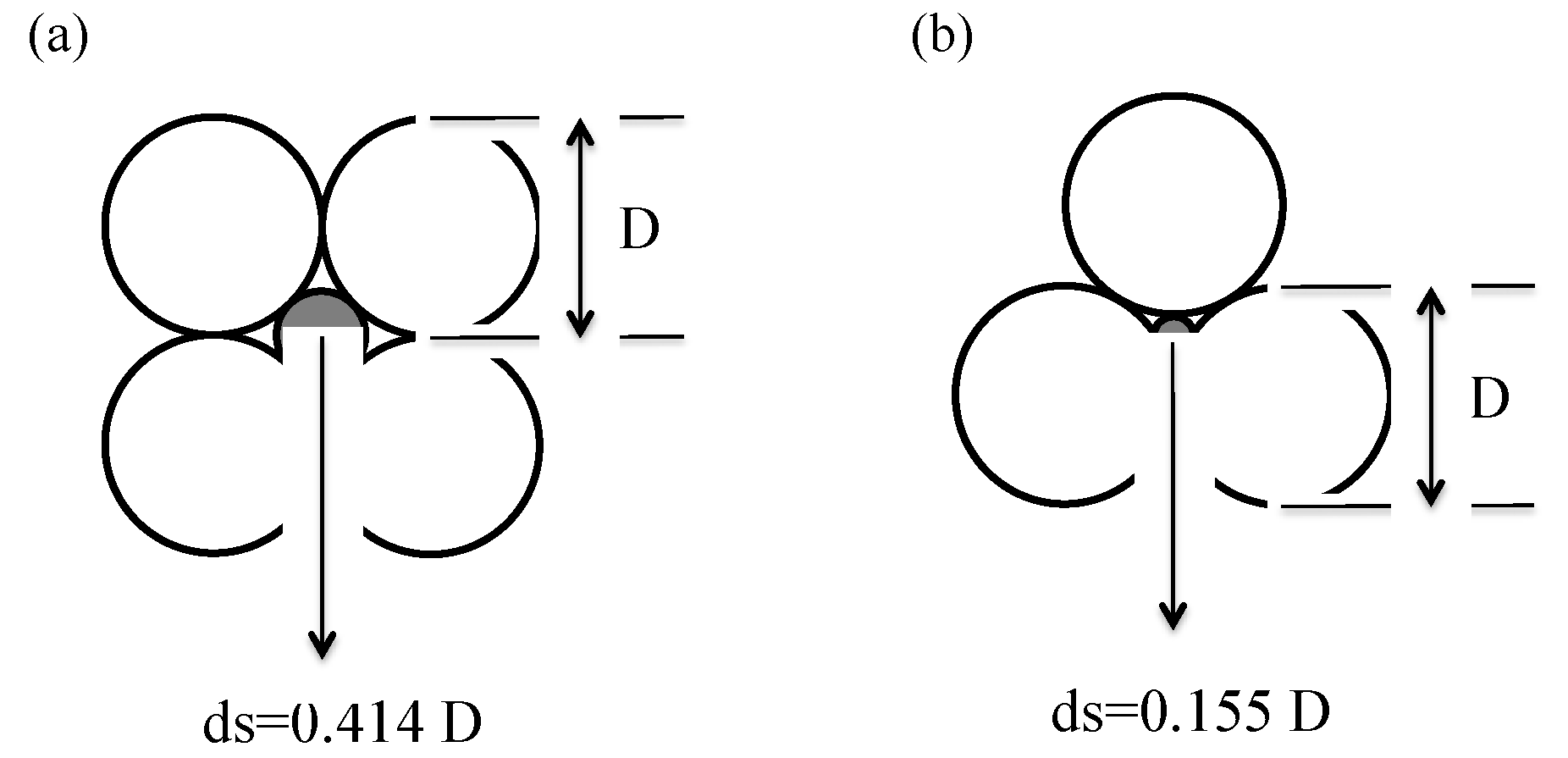
5.2. Constrained Modulus
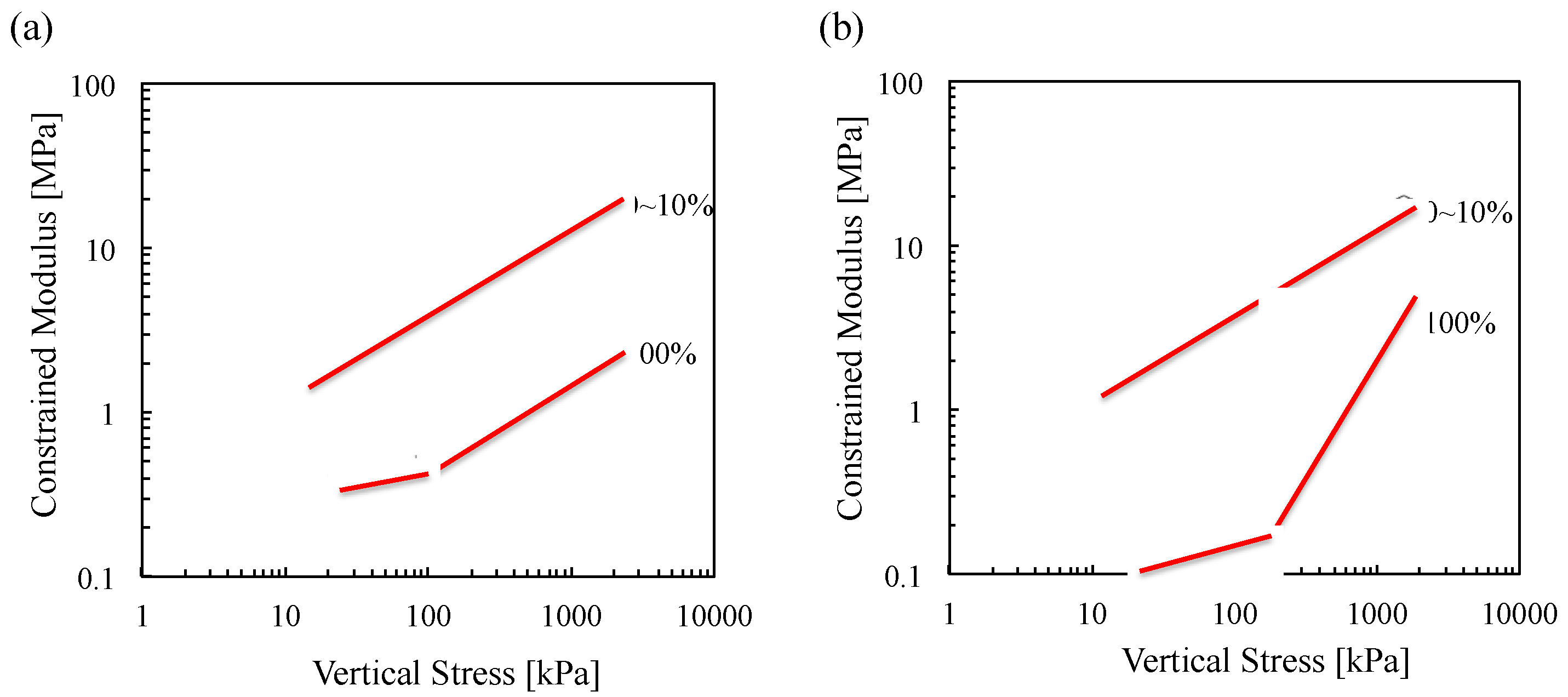

5.3. Shear Modulus
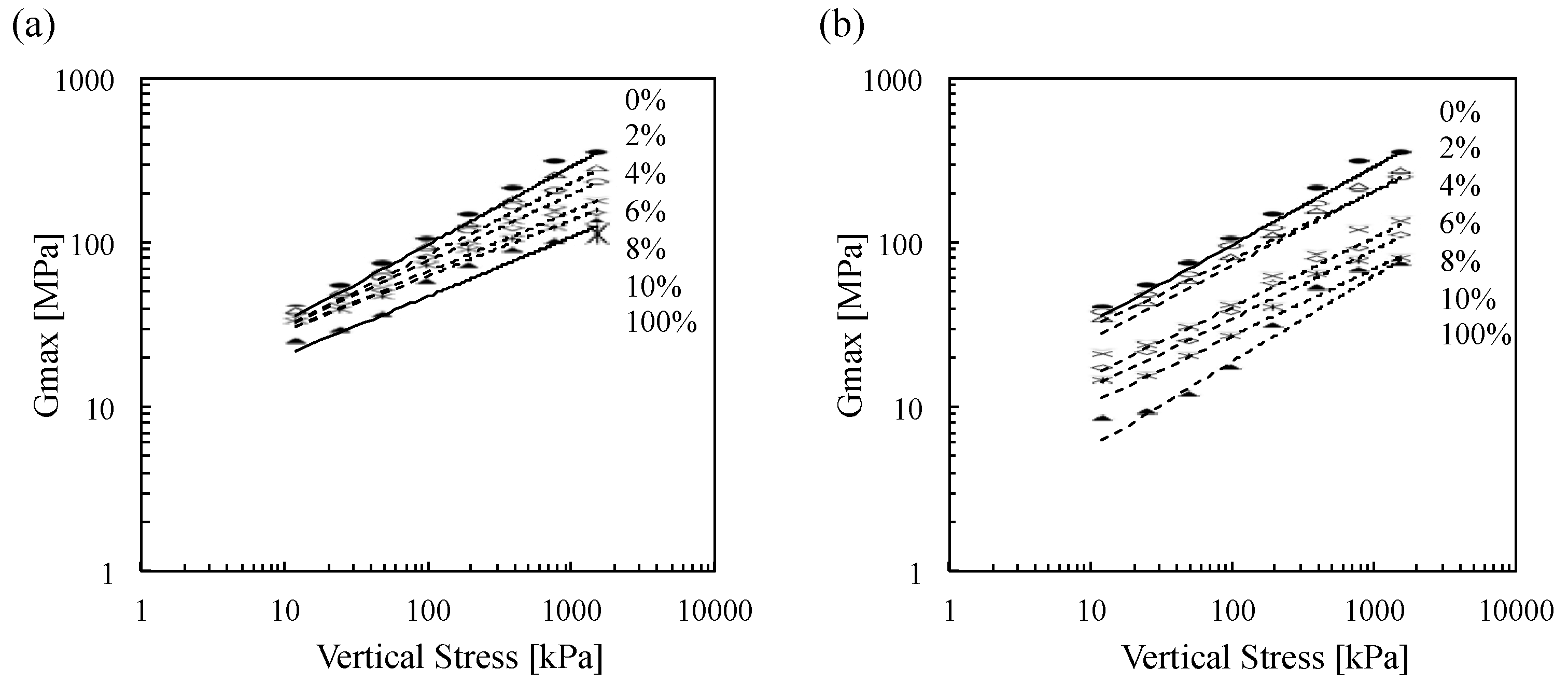

5.4. S-wave velocity and empirical relations
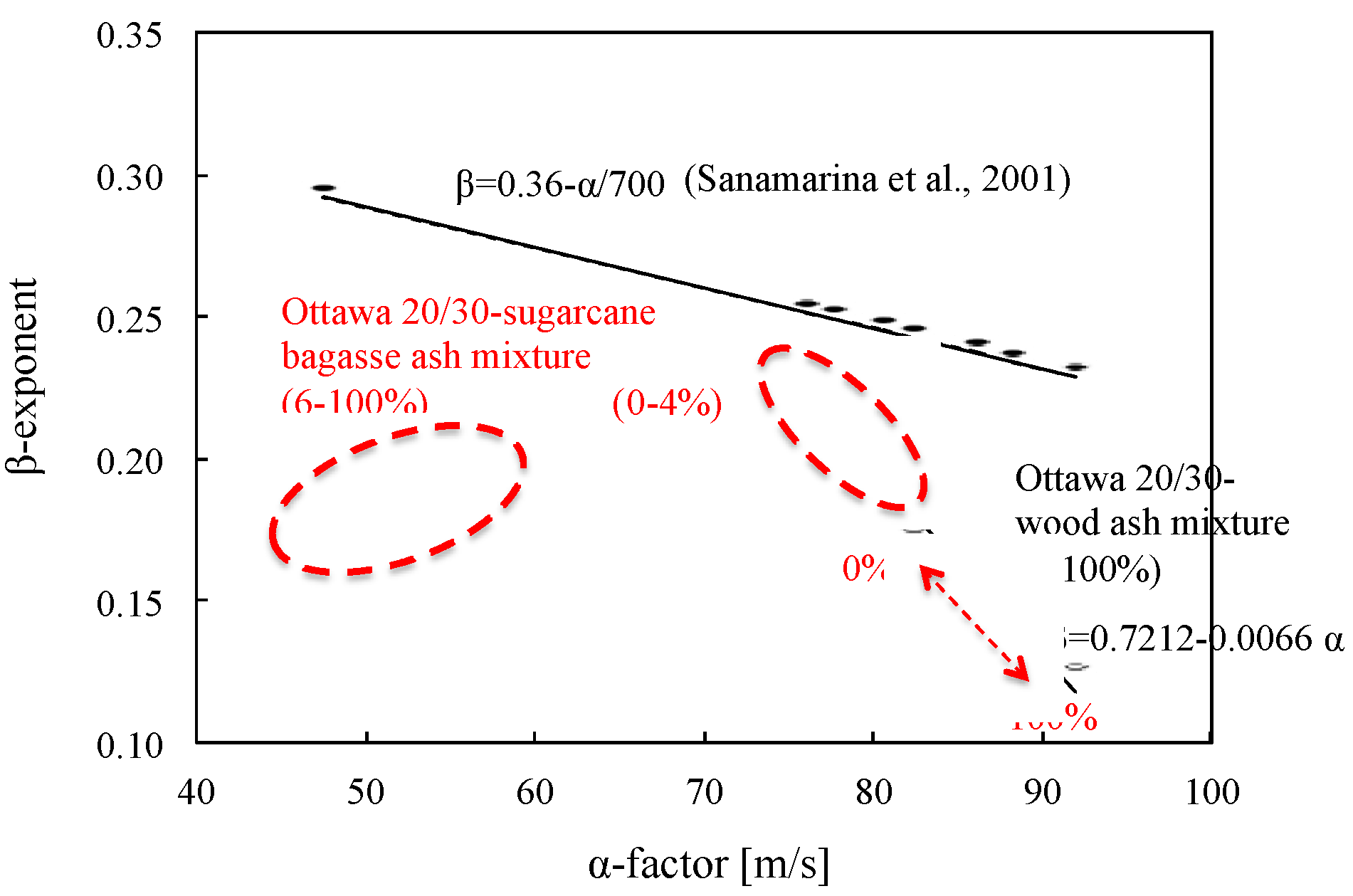
6. Conclusions
- Photomicrographs taken with SEM show that both wood ash and sugarcane bagasse ash consist of a heterogeneous mixture of different particle sizes and shapes and have a shell structure that lowers their densities. Thus, the specific gravities of wood ash (Gs = 2.41), sugarcane bagasse ash (Gs = 2.34) and coal fly ash Class C (Gs = 2.58) are less than Ottawa 20/30 sand (Gs = 2.65). Also, their shell structure results in a higher consolidation index (Cc = 1.105 for wood ash, Cc = 1.521 for sugarcane bagasse ash) than Ottawa 20/30 sand (Cc = 0.128) and a lower constrained modulus. However, the constrained moduli of wood and sugarcane bagasse ashes increase after reaching 100 and 200 kPa, respectively, because their shell structure may possibly rupture under the given pressures.
- XRD analysis displays that both wood ash and sugarcane bagasse ash mainly consist of SiO2, Al2O3, Fe2O3, MgO, K2O and CaO that are similar to coal fly ash Class C. The composition which takes up the greater portion of biomass ashes is the silicon dioxide (32.8%~84.2%, SiO2) that is responsible for the hydrophilicity and can lower hydraulic conductivity by absorbing more water.
- Wood and sugarcane bagasse ashes represent high alkalinity. Wood ash has a pH of 12.57 and sugarcane bagasse ash has a pH of 8.65, while Ottawa 20/30 sand is acidic indicating a pH of 4.01.
- Particle sizes of wood ash (d50 = 0.180 mm) and sugarcane bagasse ash (d50 = 0.055 mm) are about halfway between coal fly ash Class C (d50 = 0.022 mm) and Ottawa 20/30 sand (d50 = 0.870 mm). These smaller biomass ash particles can fill in the pore spaces between host particles of Ottawa 20/30 sand, which lowers the void ratio of Ottawa 20/30 sand–biomass ash mixtures. Thus, hydraulic conductivity values decrease significantly when replacing the soils with only 1%–2% of biomass ash. Thus, the Ottawa 20/30 sand–biomass ash mixtures can be used to decrease the hydraulic conductivity of geotechnical structures.
- Constrained modulus and shear modulus increase in line with increasing load but decrease in line with increasing biomass ash content. Ottawa 20/30 sand has higher constrained modulus and shear modulus than biomass ash. Ottawa 20/30 sand–biomass ash mixtures containing up to 10% ash can possess a high stiffness like Ottawa 20/30 sand because smaller biomass ash particles can be placed in the pore spaces between large sand particles, and larger sand particles can form the structural skeleton. Thus, the applied stress should be transferred mainly through the contact between large sand particles, and the contact between large particles will determine the stiffness of the soils.
- β-factor decreases in line with increasing wood ash content when the α-factor increases. However, in case of sugarcane bagasse ashes, α and β parameters follow similar relations as Equation (5) with lower sugarcane bagasse ash content (0%–4%). However, β factors rarely show constant values with higher sugarcane bagasse ash content (6%–100%).
Acknowledgments
Author Contributions
Conflicts of Interest
References
- Athanasopoulou, A. Addition of lime and fly ash to improve highway subgrade soils. J. Mater. Civil Eng. 2013, 26, 773–775. [Google Scholar] [CrossRef]
- Sumer, M. Compressive strength and sulfate resistance properties of concretes containing Class F and Class C fly ashes. Constr. Build. Mater. 2012, 34, 531–536. [Google Scholar] [CrossRef]
- Tastan, E.O.; Edil, T.B.; Benson, C.H.; Aydilek, A.H. Stabilization of organic soils with fly ash. J. Geotech. Geoenviron. Eng. 2011, 137, 819–833. [Google Scholar] [CrossRef]
- Kumar, A.; Walia, B.S.; Bajaj, A. Influence of fly ash, lime, and polyester fibers on compaction and strength properties of expansive soil. J. Mater. Civil Eng. 2007, 19, 242–248. [Google Scholar] [CrossRef]
- Field, C.B.; Campbell, J.E.; Lobell, D.B. Biomass energy: The scale of the potential resource. Trends Ecol. Evolut. 2008, 23, 65–72. [Google Scholar] [CrossRef] [PubMed]
- U.S. Department of Energy. U.S. Billion-Ton Update: Biomass Supply for a Bioenergy and Bioproducts Industry. Avalible online: http://www1.eere.energy.gov/bioenergy/pdfs/billion_ton_update.pdf (accessed on 30 September 2015).
- Clarke, S.; Preto, F. Biomass burn characteristics. Avalible online: http://www.omafra.gov.on.ca/english/engineer/facts/11-033.pdf (accessed on 30 September 2015).
- Udoeyo, F.F.; Inyang, H.; Young, D.T.; Oparadu, E.E. Potential of wood waste ash as an additive in concrete. J. Mater. Civil Eng. 2006, 18, 605–611. [Google Scholar] [CrossRef]
- Chusilp, N.; Jaturapitakkul, C.; Kiattikomol, K. Utilization of bagasse ash as a pozzolanic material in concrete. Constr. Build. Mater. 2009, 23, 3352–3358. [Google Scholar] [CrossRef]
- Edeh, J.E.; Agbede, I.O.; Tyoyila, A. Evaluation of sawdust ash stabilized lateritic soil as highway pavement material. J. Mater. Civil Eng. 2013, 26, 367–373. [Google Scholar] [CrossRef]
- Chauhan, M.; Mittal, S.; Mohanty, B. Performance evaluation of silty sand subgrade reinforced with fly ash and fibre. Geotext. Geomembr. 2008, 26, 429–435. [Google Scholar] [CrossRef]
- Dutta, R.K. Effect of cement on the engineering properties of sand: A comparative study. Road Mater. Pavement Des. 2008, 9, 323–332. [Google Scholar] [CrossRef]
- Milbrandt, A. A Geographic Perspective on the Current Biomass Resource Availability in the United States; United States Department of Energy: Washintong, DC, USA, 2005; p. 70.
- Huntrods, D.; Koundinya, V. Sugarcane Profile. Available online: http://www.agmrc.org/commodities__products/grains__oilseeds/sugarcane-profile/ (accessed on 30 September 2015).
- U.S. Department of Agriculture (USDA). The Economic Feasibility of Ethanol Production from Sugar in the United States. Available online: http://www.fsa.usda.gov/Internet/FSA_File/ethanol_fromsugar_july06.pdf (accessed on 30 September 2015).
- Genty, T.; Bussière, B.; Benzaazoua, M.; Zagury, G.J. Capacity of wood ash filters to remove iron from acid mine drainage: Assessment of Retention mechanism. Mine Water Environ. 2012, 31, 273–286. [Google Scholar] [CrossRef]
- Etiégni, L.; Campbell, A.G. Physical and chemical characteristics of wood ash. Bioresour. Technol. 1991, 37, 173–178. [Google Scholar] [CrossRef]
- Naik, T.R.; Kraus, R.N.; Siddique, R. Demonstration of manufacturing technology for concrete and CLSM utilizing wood ash from Wisconsin. Available online: http://www4.uwm.edu/cbu/abstracts/04-551.pdf (accessed on 30 September 2015).
- Ganesan, K.; Rajagopal, K.; Thangavel, K. Evaluation of bagasse ash as supplementary cementitious material. Cem. Concr. Compos. 2007, 29, 515–524. [Google Scholar] [CrossRef]
- Guo, Y.; Zhao, C.; Chen, X.; Li, C. CO2 capture and sorbent regeneration performances of some wood ash materials. Appli. Energy 2015, 137, 26–36. [Google Scholar] [CrossRef]
- Amin, N. Use of bagasse ash in concrete and its impact on the strength and chloride resistivity. J. Mater. Civil Eng. 2010, 23, 717–720. [Google Scholar] [CrossRef]
- Kutchko, B.G.; Kim, A.G. Fly ash characterization by SEM–EDS. Fuel 2006, 85, 2537–2544. [Google Scholar] [CrossRef]
- Misra, M.K.; Ragland, K.W.; Baker, A.J. Wood ash composition as a function of furnace temperature. Biomass Bioenergy 1993, 4, 103–116. [Google Scholar] [CrossRef]
- Grzeszczyk, S.; Lipowski, G. Effect of content and particle size distribution of high-calcium fly ash on the rheological properties of cement pastes. Cement Concr. Res. 1997, 27, 907–916. [Google Scholar] [CrossRef]
- Abdullahi, M. Characteristics of wood ash/OPC concrete. Leonardo Electron. J. Pract. Technol. 2006, 8, 9–16. [Google Scholar]
- Teixeira, S.R.; de Souza, A.E.; de Almeida Santos, G.T.; Vilche Peña, A.F.; Miguel, A.G. Sugarcane bagasse ash as a potential quartz replacement in red ceramic. J. Am. Ceram. Soc. 2008, 91, 1883–1887. [Google Scholar] [CrossRef]
- American Coal Ash Association. Fly Ash Facts for Highway Engineers; American Coal Ash Association: Aurora, CO, USA, 1995. [Google Scholar]
- Lee, J.S.; Santamarina, J.C. Bender elements: Performance and signal interpretation. J. Geotech. Geoenviron. Eng. 2005, 131, 1063–1070. [Google Scholar] [CrossRef]
- Fernandez, A.L. Tomographic Imaging the State of Stress. Ph.D. Thesis, Georgia Institute of Technology, Atlanta, GA, USA, 2000. [Google Scholar]
- Geliga, E.A.; Ismail, D.S.A. Geotechnical properties of fly ash and its application on soft soil stabilization. UNIMAS E J. Civil Eng. 2010, 1, 1–6. [Google Scholar]
- Ban, C.C.; Ramli, M. The implementation of wood waste ash as a partial cement replacement material in the production of structural grade concrete and mortar: An overview. Resour. Conserbation Recycl. 2011, 53, 1–17. [Google Scholar]
- Cordeiro, G.C.; Filho, R.D.; de Almeida, R.S. Influence of ultrafine wet grinding on pozzolanic activity of submicrometre sugar cane bagasse ash. Adv. Appli.Ceram. 2011, 110, 453–456. [Google Scholar] [CrossRef]
- Goetz, R.O. Investigation into Using Air in the Permeability Testing of Granular Soils; The University of Michigan: Ann Arbor, MI, USA, 1971. [Google Scholar]
- Method 1113 Toxicity Characteristic Leaching Procedure. Avalible online: http://www3.epa.gov/epawaste/hazard/testmethods/sw846/pdfs/1311.pdf (accessed on 30 September 2015).
- Fleshman, M.S. Laboratory Modeling of Critical Hydraulic Conditions for the Initiation of Piping. Marster’s Thesis, Utah State University, Logan, UT, USA, 2012. [Google Scholar]
- Roesler, S.K. Anisotropic shear modulus due to stress anisotropy. J. Geotech. Eng. Div. 1979, 105, 871–880. [Google Scholar]
- Santamarina, J.C.; Klein, K.; Fam, M. Soils and waves: Particulate materials behavior, characterization and process monitoring. J. Soil Sedim. 2001, 1, 130. [Google Scholar] [CrossRef]
- Murray, E.J.; Jones, R.H.; Rix, D.W. Relative Importance of Factors Influencing the Permeability of Clay Soils. Available online: http://www.murrayrix.co.uk/murrayrix/PERMEABILITY.pdf (accessed on 30 September 2015).
- Hough, B.K. Basic Soils Engineering; The Ronald Press Company: New York, NY, USA, 1957; p. 513. [Google Scholar]
- Osinubi, K.; Moses, G. Compacted Foundry Sand Treated with Bagasse Ash As Hydraulic Barrier Material. In Geo-Frontiers 2011; Han, J., Alzamora, D.E., Eds.; American Society of Civil Engineers: Reston, VA, USA, 2011; pp. 915–925. [Google Scholar]
- Kolawole, J.; Osinubi, K.; Adrian, O.; Ebemeru, A. Hydraulic conductivity of compacted lateritic soil treated with bagasse ash. Int. J. Environ. Waste Manag. 2013, 11. [Google Scholar] [CrossRef]
- Anshits, N.N.; Mikhailova, O.A.; Salanov, A.N.; Anshits, A.G. Chemical composition and structure of the shell of fly ash non-perforated cenospheres produced from the combustion of the Kuznetsk coal (Russia). Fuel 2010, 89, 1849–1862. [Google Scholar] [CrossRef]
- Salgado, R.; Bandini, P.; Karim, A. Shear strength and stiffness of silty sand. J. Geotech. Geoenviron. Eng. 2000, 126, 451–462. [Google Scholar] [CrossRef]
- Iwasaki, T.; Tatsuoka, F. Dynamic soil properties with emphasis on comparison of laboratory tests and field measurements. Avalible online: http://www.iitk.ac.in/nicee/wcee/article/6_vol3_2303.pdf (accessed on 30 September 2015).
© 2015 by the authors; licensee MDPI, Basel, Switzerland. This article is an open access article distributed under the terms and conditions of the Creative Commons by Attribution (CC-BY) license (http://creativecommons.org/licenses/by/4.0/).
Share and Cite
Grau, F.; Choo, H.; Hu, J.W.; Jung, J. Engineering Behavior and Characteristics of Wood Ash and Sugarcane Bagasse Ash. Materials 2015, 8, 6962-6977. https://doi.org/10.3390/ma8105353
Grau F, Choo H, Hu JW, Jung J. Engineering Behavior and Characteristics of Wood Ash and Sugarcane Bagasse Ash. Materials. 2015; 8(10):6962-6977. https://doi.org/10.3390/ma8105353
Chicago/Turabian StyleGrau, Francisco, Hyunwook Choo, Jong Wan Hu, and Jongwon Jung. 2015. "Engineering Behavior and Characteristics of Wood Ash and Sugarcane Bagasse Ash" Materials 8, no. 10: 6962-6977. https://doi.org/10.3390/ma8105353





